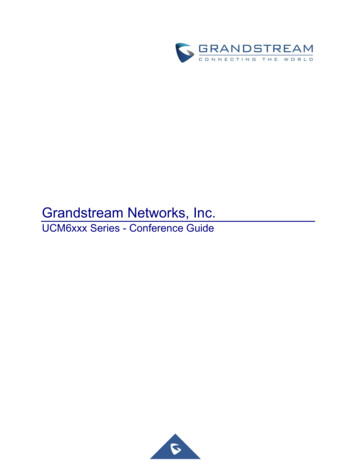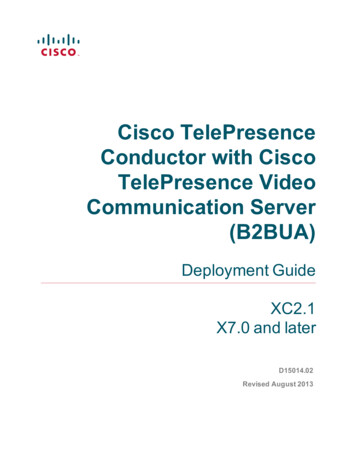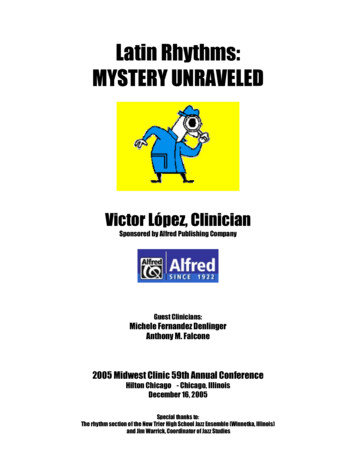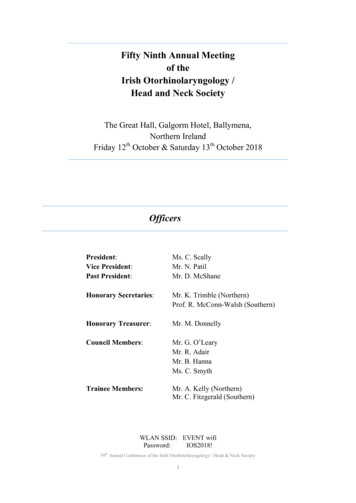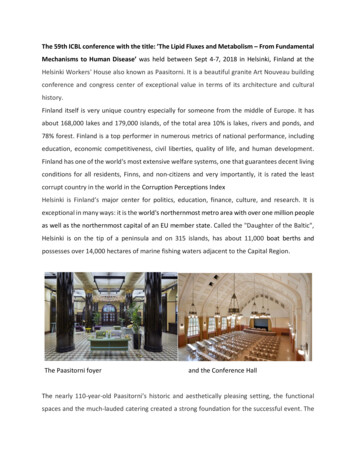
Transcription
The 59th ICBL conference with the title: ’The Lipid Fluxes and Metabolism – From FundamentalMechanisms to Human Disease’ was held between Sept 4-7, 2018 in Helsinki, Finland at theHelsinki Workers' House also known as Paasitorni. It is a beautiful granite Art Nouveau buildingconference and congress center of exceptional value in terms of its architecture and culturalhistory.Finland itself is very unique country especially for someone from the middle of Europe. It hasabout 168,000 lakes and 179,000 islands, of the total area 10% is lakes, rivers and ponds, and78% forest. Finland is a top performer in numerous metrics of national performance, includingeducation, economic competitiveness, civil liberties, quality of life, and human development.Finland has one of the world's most extensive welfare systems, one that guarantees decent livingconditions for all residents, Finns, and non-citizens and very importantly, it is rated the leastcorrupt country in the world in the Corruption Perceptions IndexHelsinki is Finland’s major center for politics, education, finance, culture, and research. It isexceptional in many ways: it is the world's northernmost metro area with over one million peopleas well as the northernmost capital of an EU member state. Called the "Daughter of the Baltic",Helsinki is on the tip of a peninsula and on 315 islands, has about 11,000 boat berths andpossesses over 14,000 hectares of marine fishing waters adjacent to the Capital Region.The Paasitorni foyerand the Conference HallThe nearly 110-year-old Paasitorni’s historic and aesthetically pleasing setting, the functionalspaces and the much-lauded catering created a strong foundation for the successful event. The
lobbies and foyers next to the conference room served as handy auxiliary areas for breaks andposter presentation. Cutting-edge technology was given everywhere in the building. Theparticipants praised the four-day meeting in Paasitorni for, among other things, the quality of thecatering and the excellent service. Some of the guests stayed conveniently under the same roof,in the distinctive Scandic Paasi hotel.The row of social events of the 59th ICBL started with the Welcome reception on September 4th,Thursday evening after the Laurens van Deenen lecture at the Congress hall foyer and lobby.Delicious snacks and very good vines were served We met with our colleagues we didn’t sincelast year’s ICBL and had nice discussions. During coffee breaks which overlapped with Postersessions we could choose from delicious cakes and great refreshments which made posterviewing very pleasant and friendly. Healthy and tasty, large choice lunches were served in thewonderful premise of Paasiravintola (Restaurant Paasi), carefully restored to the original 1920sstyle.At Thursday afternoon there was a 5 hour excursion to the e Suomenlinna Sea Fortress one ofthe largest sea fortresses in the world. Suomenlinna (‘Fortress of Finland’) fortress is aUNESCO World Heritage Site, located approximately one kilometer off the coast fromHelsinki. Suomenlinna is now one of the most popular tourist attractions in Helsinki as well as apopular picnicking spot for the city's inhabitants.As a result of two wars in the beginning of the 18th century, the Swedish Empire lost all itsprovinces and towns on the eastern border to Russia. In order not to lose all of Finland, theParliament decided to build a central fortress for the protection of the eastern parts of theempire. The construction work began in 1748 and was continued by army soldiers in thecourse of forty years, has a total of 8 km of fortified walls. It was the largest fortress of theSwedish Empire. Russia attacked Finland in 1808 and after a few weeks’ siege the fortress wassurrendered. Finland became a part of Russia and for the next 110 years the fortress served as aRussian fortress. On May 12th in 1918, the year after Finland gained independence, theFinnish flag was solemnly raised at the fortification and the fortress was renamedSuomenlinna (‘Fortress of Finland’) and served as a Finnish garrison for more than fifty years.
We were extremely lucky with the beautiful sunny weather! We went there by two ferriesand when arriving several tourist guides were waiting for us. We made smaller groups andstarted to discover the island and the fortress with their guide.The ship-builing yard
We visited the most important places and had the historical stories of that place also. At theend there was a nice surprise, free delicious cake was served and several of us had somelocal beer at a nice open-air sunny place.We went back to the town on our own with regular ferries and enjoyed again the view of thetown. Until the conference dinner we had some time and some of us walked to the largepublic plaza, Senate Square, next to Helsinki Cathedral. The square features manyexceptional examples of neoclassical architecture. The main building of the University ofHelsinki, the Government Palace and the National Library of Finland. The Helsinki Cathedralis an outstanding example of neoclassical-style architecture and features brilliant façades andimpressive Corinthian pillars, magnificent Twelve Apostles on the church’s roof, one of the largestcollections of zinc sculptures in the world. These sculptures are about 3 meters tall and arelocated in the gables above the pillars.With 3.9 million members, he Evangelical Lutheran Church of Finland is one of the largestLutheran churches in the world and is also by far Finland's largest religious body; at the end of2017, 70.9% of Finns were members of the church.At Thursday evening the conference dinner took part in Restaurant Meripaviljonki/Sea Pavillonwhich was opened in 2015. Meripaviljonki is the first floating public building in Finland andtechnically innovative It is an eye-catching, modern addition to the Helsinki Workers’ House. Theplace was just fabulous, and so was the food and wine served.At the gala dinner Fritz Spener gave a nice speech about the “spirit” of the ICBL. Laszlo Vighannounced that the Steering Committee unanimously elected Christian Wolfrum as the newpresident of ICBL from 2019. Christian Wolfrum briefly introduced his future plans for theconference which included a stronger interaction with the Asian partners.See you next year (June 17-21, 2019) in Tokyo!
SCIENTIFIC REPORTICBL 2018, Helsinki, Sept 4-7, 2018The conference consisted of a traditional Laurens Van Deenen lecture on the night of Sept4, and 6 scientific sessions during the 3 following days. The session topics wereI.II.III.IV.V.VI.Lipid-induced modulation of protein functionInter-organelle lipid traffickingRegulation of lipid synthesis, catabolism and storageNovel lipid probes for studying lipid transport and metabolismLipids in inflammationLipids as markers for health and diseaseand harboured a total of 14 invited speakers including the Van Deenen lecturer RosalindColeman (Chapel Hill, Univ. of North Carolina, US), as well as 20 oral presentationsselected from the abstracts.The Van Deenen lecturer Rosalind Coleman gave en excellent overview and historicalsketch of the lines of research elucidating how diffrent lipid synthetic enzyme isoformsacting as parts of multienzyme assemblies channel their fatty acyl and lipid products todistinct metabolic pathways and subcellular destinations.In session I, Christian Eggeling (Oxford, UK) described his group’s work addressingnanoscale molecule clusters in membranes by super-resolution microscopy, fluorescencecorrelation spectroscopy (FCS), and giant plasma membrane vesicles, while ChristopheLamaze (Paris, France) reported data on the compartmentalization of interferon-gammareceptor, the diffusion of which is controlled by membrane sphingolipids and F-actin.Kencheng Zhou (Helsinki) continued on the use of cross-linkable ceramide (Cer) to studythe structure-function relationships in the Cer transporter LAPTM4B, reportingregulation of mTORC1 signaling by this protein. In the 2nd half of the session MarkSansom (Oxford, UK) described progress in molecular dynamics simulations of membraneproteins such as Kir channels, Polycystin-2 and TRPV1 channel.In session II Tim Levine (London, UK) gave an excellent overview of the vast variety ofproteins that transport lipids, making use of his extensive bioinformatic analyses aimed atidentifying such components in different organisms, while Bruno Mesmin (Valbonne,France) presented the latest data on the countercurrent transport of cholesterol and PI4Pat ER-trans-Golgi contacts by OSBP, the functional interplay of OSBP with PI-4-kinases inthe Golgi, and on the novel role of the N-terminal unsructured region of OSBP, whichprevents the protein from packing too tightly at the ER-Golgi junctions. Cécile Bandet(Paris, France) showed interesting data on an important new role of ceramide transporter(CERT) in muscle insulin signaling under lipotoxic conditions.In session III Gary Lewis (Toronto, Canada) focused on intestinal chylomicron assemblyand secretion, and its regulation by insulin, bringing up new regulatory aspects of theprocess, including its manipulation by GLP-2 and triggering of intestinal lipid secretion byglucose bolus, which also impacts the chylomicron particle size. Toyoshi Fujimoto(Nagoya, Japan) introduced the concept of intranuclear lipid droplets (mainly inhepatocytes), how they are formed, which protein componts are found on their surface,and how they can be pharmacologically manipulated; The function of these intriguing
structures remains, however, as yet largely unknown. Andrew Brown (Sydney, Australia)reported on a conserved degron and cholesterol-responsive control of a key enzyme incholesterol synthesis, squalene mono-oxygenase (SM).In session IV Christer Ejsing (Odense, Denmark) described the remodeling of adipocytelipidome during adipogenic differentiation, by approaches combining MS lipidomics withgene knock-outs and gene expression analyses. Nicolas Vitale (Strasbourg, France)reported on the importance of phosphatidic acid (PA) and the phospholipase Dsgenerating PA, for phagocytosis, and Shin-ya Morita (Otsu City, Japan) new enzymaticfluorometric methods for quantification of phospholipid classes. Luis Loura (Coimbra,Portugal) nicely outlined how the available lipid probes gauge and affect the structure ofmembranes, observations that definitely need to be considered with caution when usingvarious lipid probes and interpreting data obtained by employing them.In session V Charles Serhan (Harvard, US) gave an excellent overview of resolvins andspecialized proresolving mediators (SPMs), and outlined progress in the design ofagonists of the resolvin and SPM pathways for therapeutic use. The 2nd invited lecture inthis session was given by Nicolas Flamand (Quebec City, Canada), who reported onendocannabinoids and their CB1 and CB2 receptors, CB2 receptor agonists being inclinical trials for autoimmune disorders such as osteoarthritis, lupus e. and Crohn’sdisease. Moreover, he showed data on 2-AG (endocannabinoid) hydrolases expressed indifferent cell types including leukocytes.In the final session VI Markus Wenk (Singapore) focused on the intra-individualvariability of the lipidome over time, analyzed in the Singapore Lipidomics Incubator(SLING) and the National University of Singapore (NUS), and how this could be made useof in future personalized medicine. Shinji Yokoyama (Chubu, Japan) reported that 2 apoAII molecules can replace one apoA-I on the surface of HDL, apparently making the HDLmetabolically less active; He showed data suggesting the the plasma LpA-I/A-II ratio doesnot correlate negatively with apoB like the concentration of LpA-I does. Maija Ruuth(Helsinki) presented new datra suggesting, based on an LDL aggregation assay, thatPCSK9 inhibition not only reduces LDL-cholesterol but also improves the quality of LDL.Gabor Tigyi (Memphis, US) reported interesting findings on role of autotaxinlysophosphatidic acid (LPA) axis in the cancer stem cell-tumor microenvironmentinteraction. Daniel Ory (St. Louis, US), gave the final invited talk on new diagnosticapproaches and therapies of Niemann-Pick type C cholesterol/sphingolipid storagedisorder.The conference was finished by presentation of ICBL 2019, Tokyo, by Makoto Arita, andthe awards. Vesa Olkkonen delivered the young investigator awards for the best oral(Maija Ruuth, Wihuri Research Institute, Helsinki) and poster (Nikolas Giannakis, Univ. ofDebrecen, Hungary) presentations. Markus Wenk thereafter delivered the J. Lipid Res.Junior investigator award to Bruno Mesmin (Univ. of Nice Sophia Antipolis, France).Warmest congratulations to the winners!
Maija Ruuth (young ivestigator award for oral presentations), Vesa Olkkonen(organizer),and Bruno Mesmin (JLR Junior investigator award)Nikolas Giannakis (young investigator award for posters)See you next year (June 17-21, 2019) in Tokyo!Vesa Olkkonen, prof.Chair of the Local Organizing Committee
catering and the excellent service. Some of the guests stayed conveniently under the same roof, in the distinctive Scandic Paasi hotel. The row of social events of the 59th ICBL started with the Welcome reception on September 4. th, Thursday evening after the Laurens van Deenen lecture at the Congress hall foyer and lobby.




